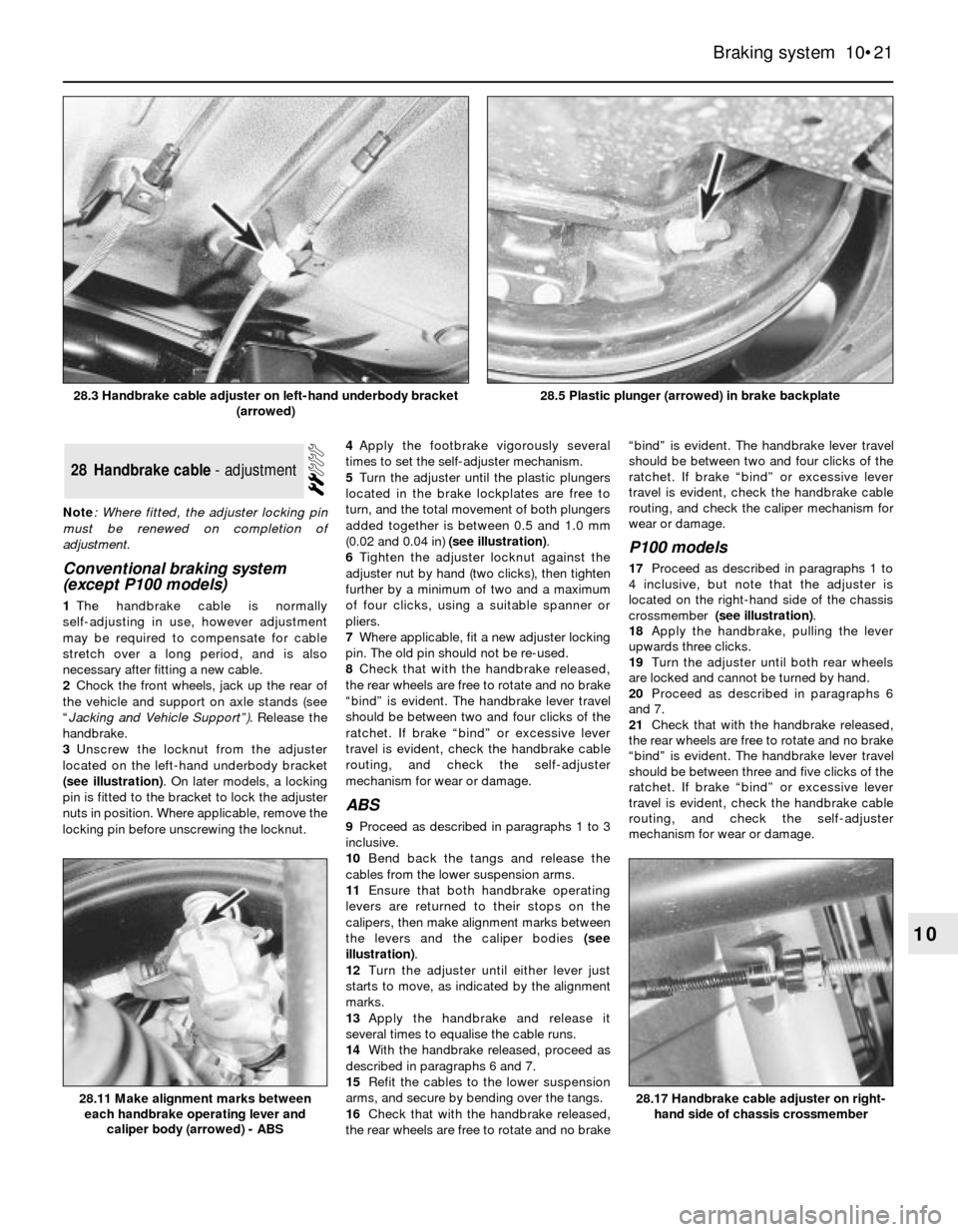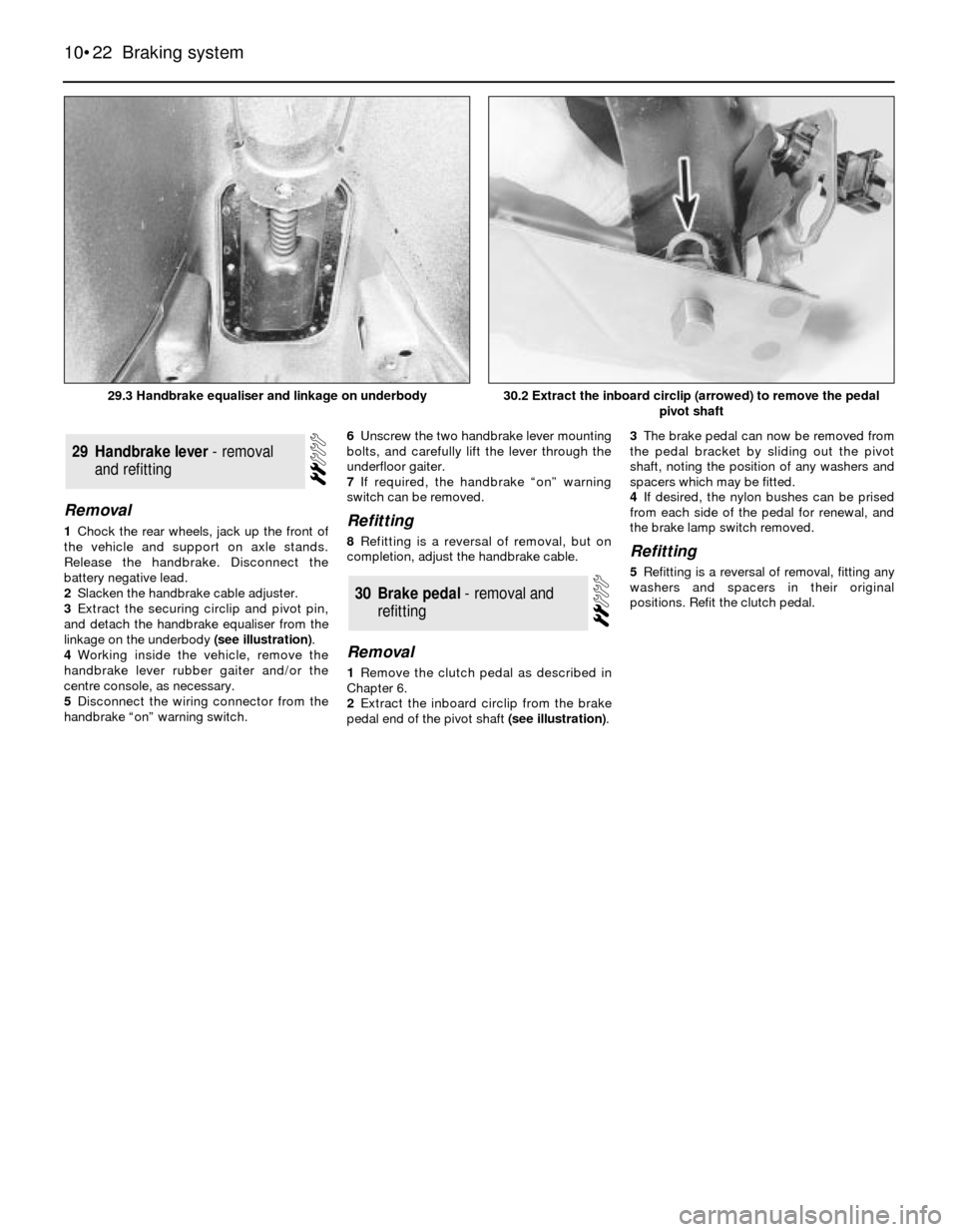FORD SIERRA 1982 1.G Braking System Owner's Manual
Manufacturer: FORD, Model Year: 1982, Model line: SIERRA, Model: FORD SIERRA 1982 1.GPages: 22, PDF Size: 1.11 MB
Page 21 of 22

Note: Where fitted, the adjuster locking pin
must be renewed on completion of
adjustment.
Conventional braking system
(except P100 models)
1The handbrake cable is normally
self-adjusting in use, however adjustment
may be required to compensate for cable
stretch over a long period, and is also
necessary after fitting a new cable.
2Chock the front wheels, jack up the rear of
the vehicle and support on axle stands (see
“Jacking and Vehicle Support”).Release the
handbrake.
3Unscrew the locknut from the adjuster
located on the left-hand underbody bracket
(see illustration). On later models, a locking
pin is fitted to the bracket to lock the adjuster
nuts in position. Where applicable, remove the
locking pin before unscrewing the locknut.4Apply the footbrake vigorously several
times to set the self-adjuster mechanism.
5Turn the adjuster until the plastic plungers
located in the brake lockplates are free to
turn, and the total movement of both plungers
added together is between 0.5 and 1.0 mm
(0.02 and 0.04 in) (see illustration).
6Tighten the adjuster locknut against the
adjuster nut by hand (two clicks), then tighten
further by a minimum of two and a maximum
of four clicks, using a suitable spanner or
pliers.
7Where applicable, fit a new adjuster locking
pin. The old pin should not be re-used.
8Check that with the handbrake released,
the rear wheels are free to rotate and no brake
“bind” is evident. The handbrake lever travel
should be between two and four clicks of the
ratchet. If brake “bind” or excessive lever
travel is evident, check the handbrake cable
routing, and check the self-adjuster
mechanism for wear or damage.
ABS
9Proceed as described in paragraphs 1 to 3
inclusive.
10Bend back the tangs and release the
cables from the lower suspension arms.
11Ensure that both handbrake operating
levers are returned to their stops on the
calipers, then make alignment marks between
the levers and the caliper bodies (see
illustration).
12Turn the adjuster until either lever just
starts to move, as indicated by the alignment
marks.
13Apply the handbrake and release it
several times to equalise the cable runs.
14With the handbrake released, proceed as
described in paragraphs 6 and 7.
15Refit the cables to the lower suspension
arms, and secure by bending over the tangs.
16Check that with the handbrake released,
the rear wheels are free to rotate and no brake“bind” is evident. The handbrake lever travel
should be between two and four clicks of the
ratchet. If brake “bind” or excessive lever
travel is evident, check the handbrake cable
routing, and check the caliper mechanism for
wear or damage.
P100 models
17Proceed as described in paragraphs 1 to
4 inclusive, but note that the adjuster is
located on the right-hand side of the chassis
crossmember (see illustration).
18Apply the handbrake, pulling the lever
upwards three clicks.
19Turn the adjuster until both rear wheels
are locked and cannot be turned by hand.
20Proceed as described in paragraphs 6
and 7.
21Check that with the handbrake released,
the rear wheels are free to rotate and no brake
“bind” is evident. The handbrake lever travel
should be between three and five clicks of the
ratchet. If brake “bind” or excessive lever
travel is evident, check the handbrake cable
routing, and check the self-adjuster
mechanism for wear or damage.
28Handbrake cable - adjustment
Braking system 10•21
10
28.5 Plastic plunger (arrowed) in brake backplate
28.17 Handbrake cable adjuster on right-
hand side of chassis crossmember28.11 Make alignment marks between
each handbrake operating lever and
caliper body (arrowed) - ABS
28.3 Handbrake cable adjuster on left-hand underbody bracket
(arrowed)
Page 22 of 22

Removal
1Chock the rear wheels, jack up the front of
the vehicle and support on axle stands.
Release the handbrake. Disconnect the
battery negative lead.
2Slacken the handbrake cable adjuster.
3Extract the securing circlip and pivot pin,
and detach the handbrake equaliser from the
linkage on the underbody (see illustration).
4Working inside the vehicle, remove the
handbrake lever rubber gaiter and/or the
centre console, as necessary.
5Disconnect the wiring connector from the
handbrake “on” warning switch. 6Unscrew the two handbrake lever mounting
bolts, and carefully lift the lever through the
underfloor gaiter.
7If required, the handbrake “on” warning
switch can be removed.Refitting
8Refitting is a reversal of removal, but on
completion, adjust the handbrake cable.
Removal
1Remove the clutch pedal as described in
Chapter 6.
2Extract the inboard circlip from the brake
pedal end of the pivot shaft (see illustration).3The brake pedal can now be removed from
the pedal bracket by sliding out the pivot
shaft, noting the position of any washers and
spacers which may be fitted.
4If desired, the nylon bushes can be prised
from each side of the pedal for renewal, and
the brake lamp switch removed.
Refitting
5Refitting is a reversal of removal, fitting any
washers and spacers in their original
positions. Refit the clutch pedal.
30Brake pedal - removal and
refitting
29Handbrake lever -removal
andrefitting
10•22Braking system
29.3 Handbrake equaliser and linkage on underbody30.2 Extract the inboard circlip (arrowed) to remove the pedal
pivot shaft